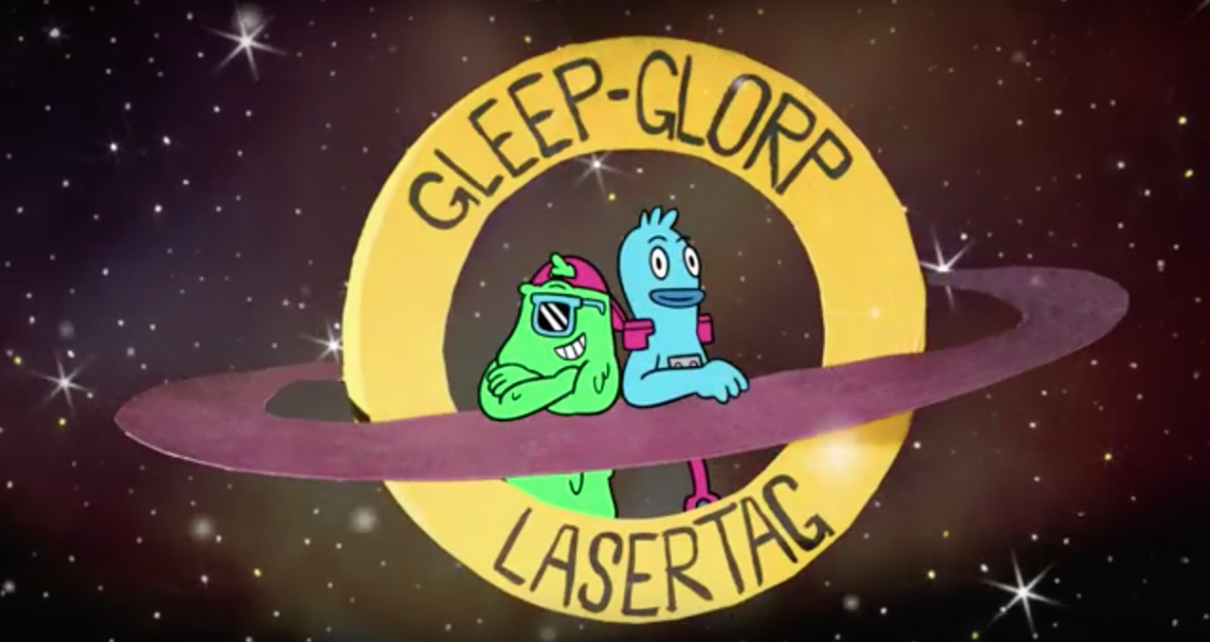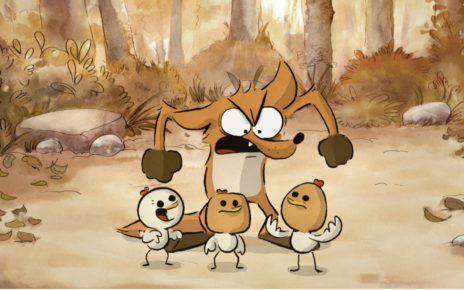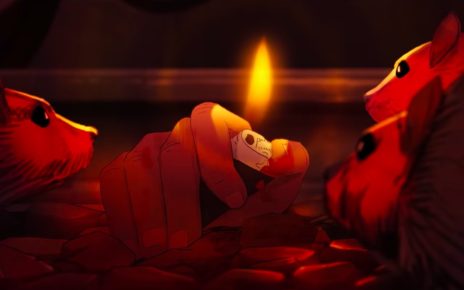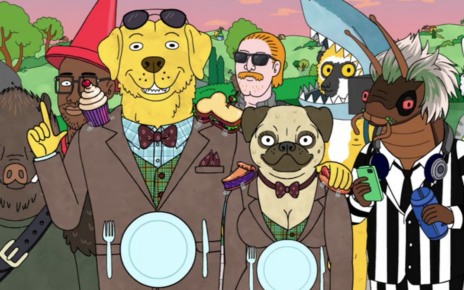You were the designer and animator for the “Gleep Glorp and Lasertag” short. Did you work primarily with Justin Michael, or was it collaborative with the whole team involved?
I know most of the people who worked on the short, but as far as working on this particular short, it was primarily working with Justin and Hans [Sahni], our producer. I storyboarded everything first, so the designs for the background then went to John Sumner and Harry Chaskin who executed those. But yes, primarily with Justin. I got his script and then I started with this sketch that was originally written to be live action and I would just draw some designs and send them to him and go back and forth from there.
Did you have a say in the look of the characters themselves?
Yes. We were really lucky that we were both on the same page. I felt like often I’d send him designs and the ones that he liked were the ones that I’d hoped he liked. It was a very collaborative process as far as the visuals went.
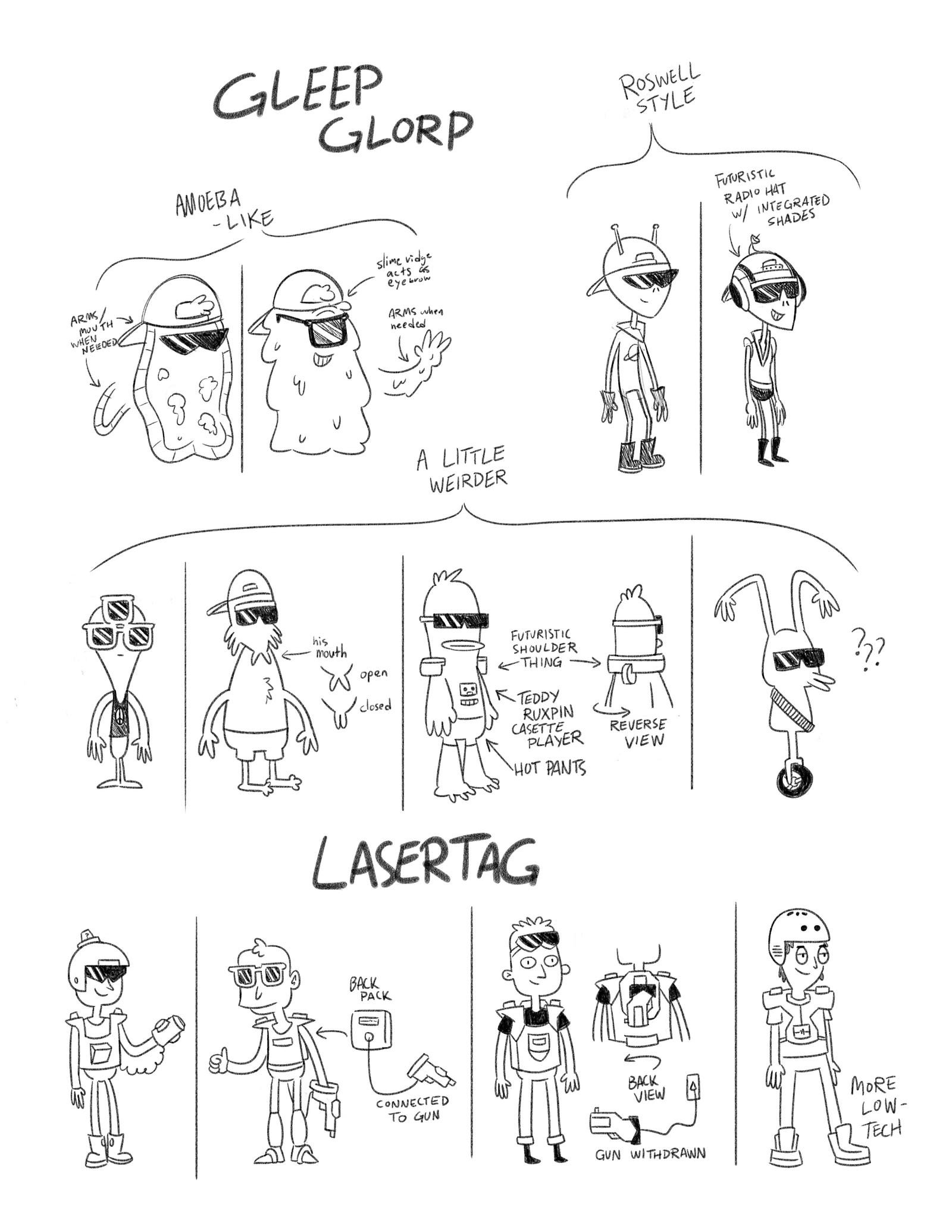
How many iterations did you go through until you were both pleased with the final product?
It was really just a few back and forth. My primary concern when designing the characters was would they be fun to animate, would they move in different ways. I think Gleep Glorp we nailed down pretty quickly because we knew we wanted there to be a slime monster. Lasertag actually started as a human.
We’re working on a pitch version of it now, and a lot of the characters in the pitch started out as different versions of characters in the short.
What changes when you’re working on the short versus working on the pitch?
Once we were finished, we thought we had a really cool world and once the characters had their voices matched too, we felt like they really came together and we especially liked Mr. Spranklebottom and wanted to make him a bigger part of their world. But it was really pretty organic. We thought the short came together well and we thought there was a bigger world there to explore. We wanted to go visit all the crazy places that you see behind them.
One trap that people fall into is over-animating. If you just keep their faces going the whole time, you don’t really settle on an expression and it makes them harder to breathe and makes them seem less alive in a weird way.
You mentioned earlier that you wanted to create characters that are fun to work on from an animation perspective. Are those more challenging? The constant oozing of Gleep Glorp or the waving eyestalks of Mr. Spranklebottom, are those more for you to have fun with? They enhance the final product too.
It was for me and for the end product. Animating is a very tedious process so you definitely want to entertain yourself, so I really wanted some characters that I felt like I could do some weird things with. Gleep Glorp wasn’t too hard because she stays relatively static, but Mr. Spranklebottom ended up being much harder than I thought he’d be, because he’s just got a lot of squash to his entire head when he talks. So he was easily the hardest person to animate. And you’ll notice that none of them have traditional legs, and that was intentional on my part.
When the characters are talking too within the short, you almost take it for granted as a viewer, but you include facial cues and gesticulations — why are those important?
I think part of it is just having good natural instincts about what faces to use in certain situations. Part of it is me watching a lot of cartoons and seeing what I like. But it’s also a lot of trial and error too. I’ve made plenty of shorts before this one even when I was a kid, and you start to see what works and doesn’t work. I think one trap that people fall into is over-animating. If you just keep their faces going the whole time, you don’t really settle on an expression and it makes them harder to breathe and makes them seem less alive in a weird way.
What are some tell-tale signs of over-animating?
I don’t know if I have a really good answer for that. It could just be a personal preference too as someone who grew up much more interested in TV animation than feature. Maybe I just naturally find that aesthetic more pleasing. Not that there’s anything wrong with Disney, that stuff’s beautiful. I think it often helps to settle on good poses.
Would you say there’s any particular show that was a catalyst for your interest in animation?
Rocko’s Modern Life is the show that made me really want to make cartoons. But the other ones that I really liked were Spongebob, Invader Zim, and Dexter’s Lab.
I really loved ‘Invader Zim.’ Such and odd show, I don’t think there was really anything like it at the time.
Yes, very unique. We have chalkboard walls on our floor and we’ve drawn a lot of Invader Zim fan-art on the wall.
Now that you do it as a career, is it harder to enjoy watching cartoons?
Possibly? I’d definitely would say my cartoon watching has gone down mostly because I’m just busy now. I was pretty much exclusively watching animation through college. It definitely kills your drive to work on personal projects because you’re essentially doing the same job twice in one day and when it comes down to it, it can be a real strain on your hands, actually. I still like cartoons just as much as I ever did. I’m definitely waiting for some more cartoon-y cartoons come back to TV. I think we’ve really trended away from the visual humor, and I’d like to see that come back.
Can you talk about that a bit more? What do you mean by cartoon-y?
Just gag-driven, fun, and wacky characters. There’s a lot of shows I still like. With Adventure Time and Steven Universe — which are great shows — but they’ve started this trend toward more story-driven and character-driven and kind of an artsy sensibility and I’m more a fan of just slapstick. Basically I want to see more slapstick in cartoons. You know, that’s probably a cultural shift too away from violence for children in cartoons.
My philosophy is that if I’m making something for kids, I never think what would kids like. I only make it appropriate for kids but it’s still what I would like and I think a lot of the best cartoons in history were made that way.
“Gleep Glorp and Lasertag” is geared towards kids, is there anything different that you do when you’re working on a project that’s geared toward children versus something that’s more adult?
No, actually my philosophy is that if I’m making something for kids, I never think what would kids like. I only make it appropriate for kids but it’s still what I would like and I think a lot of the best cartoons in history were made that way. All of the Looney Toons, even things like Ren and Stimpy or Spongebob, I don’t think there was ever a lot of thought put into how will kids respond to this. It was always the cartoonists amusing themselves.
And I think you’ll find that some of the best cartoons are enjoyable for both adults and kids.
Yes, I think that’s a huge part of it. I think as soon as you start making things for kids, when you’re not a kid it starts to feel a bit disingenuous and patronizing and I think kids pick up on that. I did do a Disney Junior short this year and that was interesting because at that point they do want you to shift your focus a bit. They were real big on over explaining things. I always think that kids can watch it again or ask a parent if they’re confused but I had a lot of notes coming back saying emphasize story points. It really wasn’t too bad but it was a lot of simplifying and repeating. It turned out pretty well, it wasn’t too bad it was definitely different for me though.
I had heard that you’re working on the ‘Rocko’s Modern Life’ reboot special. Is that something you can go into at all?
I can give you very general information. It’s already been announced, it’s a TV special. A TV movie. They haven’t really announced any more details. I’m storyboarding on it and I think it’s going to be very good. I’m very excited about it.
So that’s something that’s come full circle, you grew up on ‘Rocko’s Modern Life’ and now you’re working on it. What’s that like?
It’s absolutely insane. I don’t know if I’ll have a better job for a long time because it really was the show that made me want to make cartoons specifically. The satirical nature of it, as a kid I felt like it was speaking to a lot of truths in the world that adults were not willing to tell me yet. It’s been a really fantastic experience.
For those who may not know the process, what exactly does storyboarding entail?
So storyboarding I always like to say is basically like the blueprints of the episode. It’s essentially a non-animated black and white version of what you see later on the screen. There’s two different styles. There’s script-driven or board-driven. In a board-driven show, which is typically your kids’ cartoons with more visual humor, you’re just given an outline which is like a page or two treatment describing the episode and you just get to go from there writing and drawing. The idea being that the humor is primarily visual and you want the cartoonists to be doing the writing. For script driven, it’s really a bit more straight forward, you’re just given the script and you have to figure out how to best translate it from the paper to the screen. You’re kind of like an editor in that sense.
So I’d imagine that script-driven is a bit more collaborative between the writers and the cartoonists?
Yes, big time. I mean I don’t know if it’s collaborative between the writers. They’re typically not a part of that process once you start boarding. But it’s very collaborative in the animation respect because you’re working with a director and another boarder perhaps. Working with Justin, even though it was based off of a script, it was very collaborative because there wasn’t any sort of visual nailed down at that point. Typically on a script-driven TV show, you’re almost completely shut out of the rest of the process.
So it’s more silo’d you could say on a script driven show?
Yes, you know I think it’s interesting. I don’t think enough importance is given to the role. A director gives you his thoughts on the script and then you go from there but you’re really setting the workload for the crew and everything that the show is going to be. I think it’s a much more important job that people often give it credit for.
You’ve also done some work on ‘Robot Chicken’ as well. What was that experience like working on such a well known show?
Yes! Robot Chicken was actually my first show. I started there as a production assistant and then moved into storyboarding. I think I started in season 6. It’s a really cool show. It’s a lot of fun for me because I like to imitate whatever styles of whatever property we’re parodying just for my own practice. It’s fun to think, “Oh, I drew Big Bird pooping all day and got paid for it.” Everyone on that show is really cool. I’d watched it before but I didn’t realize before I started working there how much the show is about toys and how they’re a big part of the show. Seth [Green] and Matt [Senreich, the creators] are big toy collectors. If you’re into toys, there’s a lot of collectible and classic toys that actually get used in the show, which is really interesting.
And you also did the ‘Robot Chicken’ couch gag on ‘The Simpsons,’ right?
A couple years ago, and that was actually one of the first things I boarded. An incredibly cool opportunity. To just be thrown into The Simpsons world without much boarding experience, my drawings weren’t the best, but I did get the shots down, and I got the information that we needed for our team because you don’t need to draw on model if you’re using stop motion puppets. But I remember they had Fox send over a behind-the-scenes crew and they just wanted to get some B-roll of me drawing and I remember being so nervous that I couldn’t draw a decent-looking Homer so that did not make it into behind-the-scenes.
So what’s it like working with that ‘Simpsons’ team, did it take a while to develop or did they reach out to your team?
So they actually connected with Matt and Seth at some kind of event. I was basically still working with my same crew. But the showrunners of The Simpsons know that world so well that we’d submit something for them to look at and it would come back with these real minor notes about what the characters would or wouldn’t do, stuff like that, or if a joke had been done before. It’s tough to do something new on that show although they’re still doing it and having new episodes every year.
Definitely, I think you could say the same for ‘South Park’ as well.
Yes, absolutely. It’s kind of wild when you look at the runs of other shows and realize that most of them do about three to five seasons and you see that The Simpsons is on 20-something years. I mean, you could talk all day if the quality is the same as it used to be but they definitely have a classic episode every season, one that stands the test of time, and that’s an incredible feat.
What are you watching these days? What are your favorite shows right now?
I feel like we’re kind of on a weird shift where a lot of shows are being cancelled and the new ones haven’t come out yet. I really love Clarence on Cartoon Network. Rick and Morty is incredible. Basically that’s the show that I would have wanted to make but I didn’t think of it. I absolutely love it. You know, I actually got rid of my cable box this year so I’m not as up-to-date as I should be. The Loud House from what I’ve seen is pretty cool. I feel like a lot of the shows I really like though have gone off the air. I thought Wonder Over Yonder was fantastic.
Do you think with the recent uptick in streaming video has affected the animation industry at all?
Yes, big time. I should probably mention that I worked on a show called SuperMansion, a Crackle show. I did storyboards on season one, and then I was storyboard supervisor for season two. Season one just came out, and then season two is later this year. That’s a streaming show so the avenue it’s on didn’t exist a few years ago and it’s TV-level quality. There’s more and more of these popping up all the time. I actually think the industry is really healthy right now, not just for jobs, but to have your idea picked up and paid for.
Does it change the process at all? Does it change how you work?
No, it doesn’t change the production at all. Without getting into it too much, I know there’s a lot of weirdness about union rules not keeping up with the times. Ten years ago web content was a very different thing than it is now, and technically Netflix is considered web content. So you could technically be doing things according to union rules but they were created at a time when we only had flash cartoons. It’s kind of interesting to see how the technology is going faster than the contracts can keep up with. But it’s good, I think it’s a good time to get into animation.
If you were to give any advice to someone starting out in animation right now, what would you tell them?
To do your own work, make your own stuff even if you don’t think you have the appropriate technology to make something that looks like it could be on tv. When you’re growing up you should always be making comics or cartoons, whatever you have access to do. Even if you’re using MS Paint — which is what I did for a while. If you’re in college or just our of college and wanna try to get into cartoons I’d say the same thing applies. I’d say where you went to school matters less than what you’ve learned. There’s a lot of people who are self-taught just by reading books or studying existing animation. Once you get your foot in the door, it doesn’t matter where you went to school. The industry isn’t as closed off as one may think.
I actually just remembered that you worked on ‘Crazy Ex-Girlfriend.’
Oh yes, that was actually an incredible opportunity. When they did the pilot for SHOWTIME, and it’s still there in the CW version, there’s a tiny little bit where Rebecca jumps into a plane and it switches to animation and you see the plane fly across the country. I think they decided they needed that shot late in the animation process, so they needed it quick, and over a weekend I just did that shot. When they were doing the show, they really wanted to have a saga introduction, which is an intro that sets up the premise of the show and they wanted it in the style of Bewitched or The Nanny, you know this retro animated look. Because I made that quick animation, I was able to work on the opening titles for the show.
What excites you?
In general? I guess I really like all forms of art. Anything that can really show you the way someone else thinks and constantly trying to achieve that is what interests me in animation. I think I’m still trying to figure out what really excites me about animation. Out here in LA, work dominates your life, and I’m still trying to figure out the correct balance is between work and life.
I think if you really love what you’re doing then it doesn’t even seem like work.
Yeah. But then I’ll go surfing and think, “Why don’t I just move to some island somewhere?”
What are you afraid of?
Oh, probably going back to that same point. I feel like I put so much time and effort into what I’m working on and there’s always the question of, “Is this worth it?” Maybe that is a problem with streaming, now that there’s so many avenues for a thing to be made, it’s so easy to get your thing out there but the audience is very fragmented. You’ll bust your ass on a short for some channel’s website and then it comes out, and 20,000 people watch it, and you don’t really hear much about it and you think, “Was that really worth the amount of time I put into it?” In animation, it’s more about the time you put into it than the money you get from it.
I think these days the audience tends to be more fickle.
Even I feel like my viewing habits have really changed. I love film and I used to give a lot of time to movies that I normally wouldn’t see, just if I heard if they were good because you want to see what else is out there and challenge yourself. Having a smartphone in your hand, these days when you’re making something you have to be more engaging than something that could be in someone’s pocket at any moment. Maybe that’s a fear for all artists but just fear of never making something as good as you want to.
Thanks for reading The Dot and Line, where we talk about animation of all kinds. Don’t forget to ❤ this article and follow us on Twitter and Facebook.


